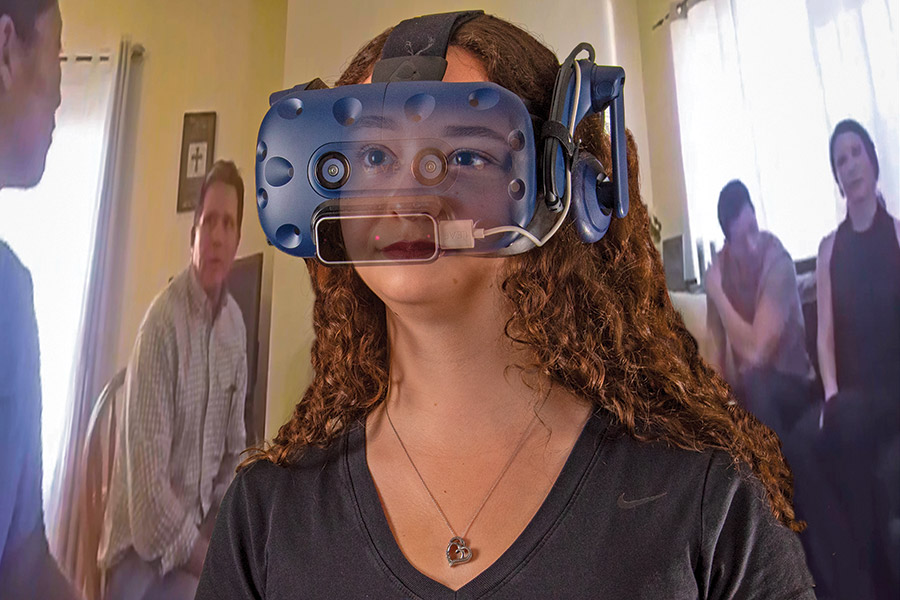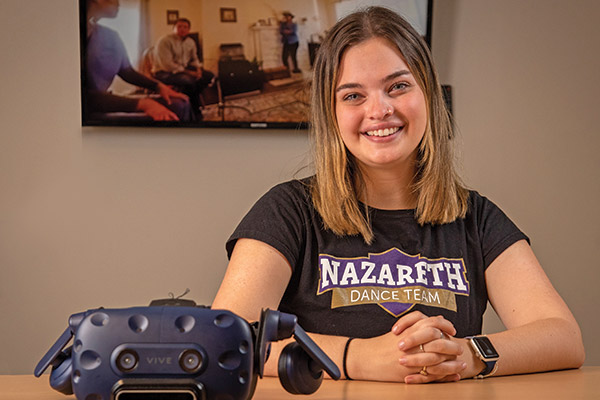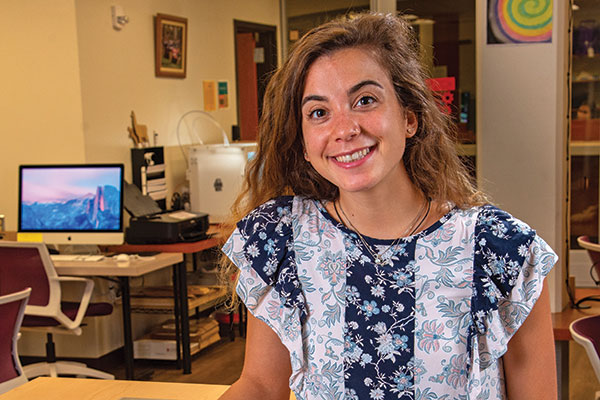LEARNING BY DOING
Virtually There
Students build empathy by experiencing hearing loss, isolation, and dementia.
by Robin L. Flanigan

Caroline Holley ’23, music therapy major, with the virtual reality equipment in Nazareth’s Makerspace.
Disorientation. Loneliness. Frustration.
Nazareth students know they’ll be working with clients and patients who are dealing with these and other difficult emotions. But their understanding of those feelings has deepened with the recent use of extended reality technology.
The fully immersive three-dimensional computer-generated simulations — in which the students see and hear what the characters see and hear — are profound and thought-provoking.
One character, Albert, has hearing loss. Frank is experiencing isolation, loneliness, and declining health. Beatriz has dementia.
Some students have left the experience crying.
“The most clear-cut gain for students is being able to envision what an individual is going through on a more visceral level,” says Leanne Charlesworth, Ph.D., chair of Nazareth College’s Social Work Department. “Beyond a shadow of a doubt, the virtual reality experience builds their empathy.”
‘I just felt so bad’
Virtual reality allows students an insight into classroom material that no amount of stand-up lecturing or reading can deliver, according to Season Bonino, clinical assistant professor and geriatric clinical specialist in the Physical Therapy Department.
“I could’ve told them what they needed to know,” she explains, “and they would've written it down and memorized it for the test; but would they have taken it forward with them and remembered when they were in a certain situation?”
Bonino used Frank’s virtual reality scenario in a summer class on physical therapy management of older adults.
One of her students was Gina Martini ’22G, a graduate student studying physical therapy.
“It was quite literally like putting yourself in someone else’s shoes,” Martini recalls. “It was almost haunting to see my hands change from not taking my medication, and from the diabetes my eyesight was starting to go. My children were too busy to talk to me. I just felt so bad. It took compassion and empathy to another level.”
As a result, Martini has committed herself to spending extra time and deepening conversations with the geriatric patients she sees as part of her clinical work.
‘Humanizing the elderly’
Virtual reality came to Nazareth College in 2019, when a virtual reality hearing loss simulation replaced a physical hearing loss simulation for undergraduate students in the communication sciences and disorders program.
The effort was a collaboration among that program, the Teaching & Learning Technologies unit, and the Makerspace, which is housed in the Lorette Wilmot Library and is where the simulations take place.
Jenna Sadue, head of teaching and learning technologies, brought the advanced simulations to Nazareth after learning about a California State University nursing school’s success in using them to help their students learn empathy in preparation for clinical rotations.
“Empathy is a really hard thing to teach,” says Sadue.
The Makerspace has three virtual reality headsets; the software comes from a third-party vendor, Embodied Labs, whose founder created the Beatriz scenario after seeing that caregivers for her mother, who had Alzheimer’s disease, weren’t as empathetic as she’d hoped.
An internal informal study that first year — in which students became “Alfred,” a man with hearing loss — produced intriguing results, which prompted other academic programs to adopt use of the platform.
Some of the words students used when referring to hearing loss before “becoming Alfred” were clinical, such as “cochlear implant,” “hearing aid,” and “tinnitus.” By the end of their time as Alfred, they were using words such as “isolating,” “scary,” and “frustrating.”
“Their verbiage changed to the idea of humanizing the elderly,” says Sadue. “It was really impactful.”
‘My heart was sinking’
When asked for feedback, the vast majority of Nazareth College students agree that they prefer experiential learning, and virtual reality is another layer of that type of learning, says Charlesworth.
It was a layer made all the more valuable when COVID-19 prevented students from interacting with patients and clients in person.
Charlesworth says that because of virtual reality, the social work and music therapy majors she works with “were able to see the complexities of each situation in a way that is hard with a case study in a textbook, such as the significance of the family system.”
In one scenario, for example, family members are having conversations about Beatriz without paying much, if any, attention to her.
“My heart was sinking,” says Caroline Holley ’23, a music therapy major. “People definitely don't understand how important it is to include other people in conversations. They think that just because they're older, they're not interested.”
Charlesworth gathered quotes from students about what they took away from the experience. One wrote, “I hadn’t understood before this experience how scary it can be to lose use of speech, cognition, memory, and motor skills, something we take for granted each day.” Another reported, “It made this disease that I have read about and seen portrayed in films much more real.”
Even though her grandmother experienced dementia and passed away in 2019, Holley says, her simulation with Beatriz — who was confused by the way relatives were arguing about her care — offered a new perspective on how difficult it must have been for her grandmother to decipher what was going on.
“If I'm working with a client who is reluctant to participate in whatever activity we’re doing, I will now be able to give them space while trying to coax them into joining in,” Holley says. “To get this experience firsthand was invaluable.”
‘The emotions and reactions are real’
Nazareth College’s School of Education uses a type of augmented reality called Mursion to help students experience parent-teacher conferences and individualized education plan (IEP) meetings prior to their field experience.
Without the pressure of real-world consequences, students role-play with an avatar, controlled in real time by an actual person skilled in expressing appropriate reactions based on their performance — complete with crossed arms or frowning faces if they’re dissatisfied.
Mursion prepares students in a way that gives them “a supported experience, where they can make mistakes,” says Jim Black, associate professor of education. “Some of the best learning comes from making a mistake or getting defensive, or maybe not communicating back in such a way that a parent feels heard.”
Black can set up the role-playing experience to be subtly challenging, relatively challenging, or extremely challenging. In each case, students are tasked with figuring out a way to help resolve a potentially stressful situation in a productive way.
Given that every scenario is different, adolescent education graduate student Khalisha Carnegie ’21G says she learned as much from watching her classmates experience Mursion as she did during her own two experiences. She witnessed, through trial and error, different ways to be a calming presence and to read a room.
“We saw the good, the bad, and the in-between,” she says.
“It’s an animation, but the emotions and reactions are real,” adds Carnegie, whose avatar was a father concerned about his son’s refusal of individualized education program (IEP) services.
Black says there's no comparison between what students get from reading about potential scenarios and high-quality role-play simulation: “This allows them to actually apply what they learn, rather than just talk about it.”
Robin Flanigan is a writer in Rochester, N.Y.

Experiencing hearing loss via the VR simulation as Alfred, "I felt confused and frustrated," says Kristin Thayer '21, '22G (communication sciences and disorders, speech-language pathology). She says she was surprised by how realistic it felt. "In the future, I will think back to this simulation when working with people with hearing loss, reminding myself to consider their perspective, feelings, and individual needs. I wanted to fully understand everything that was going on, but was unable to, and that left me feeling quite agitated."

A virtual reality experience prompted Gina Martini '22G to commit to deepen conversations with elder physical therapy patients.